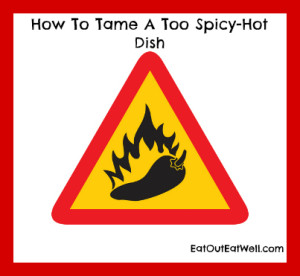 Have some chili planned for dinner? You know it’ll be a crowd pleaser – until you taste it. All you can think of is that a stray chili pepper that made it’s way into your recipe was at it’s peak of hot, hot, hot – or the lid popped off the jar of chili pepper spice – or you double dosed the pot while you were texting, tweeting, or talking.
Have some chili planned for dinner? You know it’ll be a crowd pleaser – until you taste it. All you can think of is that a stray chili pepper that made it’s way into your recipe was at it’s peak of hot, hot, hot – or the lid popped off the jar of chili pepper spice – or you double dosed the pot while you were texting, tweeting, or talking.
After a few choice words escape from your scorched mouth, other than tossing the whole dish into the garbage or feeding the compost pile, what can you do to make it palatable?
What To Do To Dial Down The Blazing Heat
There are ways to calm down an over-spiced dish. These tips (in no particular order) might or might not work for your dish depending on your taste and the other ingredients in the recipe. They’re frequently used solutions and are definitely worth a try before you’re accused of starting a 5-alarm fire.
Know your peppers – they vary in the amount of heat they have. You can always decrease the amount you use. Be sure to remove the inner membranes and seeds, which is where the majority of the heat resides. The amount of capsaicin, the active component in chili peppers, varies with the variety and maturity of the pepper. Habanero peppers are always extremely hot while ancho and paprika peppers can be as mild as a bell pepper.
Try One Or More Of These “Fix-Its”
- To ratchet 5-alarm hotness down to around 3-alarm, you can try to dilute the heat. Make another batch of the recipe and omit the the “heat” ingredient and combine it with the over-spiced batch. Now you have a double recipe that should be just about right, half of which you can freeze. You can also add more stock, broth, canned tomatoes, or beans depending on the recipe – just make certain there is no added seasoning. A can or two of refried beans or mashed canned beans helps to dilute spiciness, helps thicken chili, increases the fiber and protein content, and gives you more servings without the higher cost of more meat.
- Dairy helps neutralize the spice in a dish (and in your mouth). You can use milk (full fat is best), sour cream, or yogurt to mix into or to top the spicy stuff. Other possible dairy ingredients to add are whipping cream or evaporated milk. If you can’t or don’t have time to incorporate dairy into the dish, offer some sour cream or yogurt on the side – some cheese helps, too.
- Serve the chili or curry over rice. The rice tones down the spices and adds bulk to the recipe. Bread and other grains may also help.
- Add some potatoes or another starchy vegetable, like corn. You probably won’t even notice the corn in chili. If you use potatoes, peel and cube a couple and mix them in. Leave them in until they’re cooked through. Remove them (or not, depending on taste) and serve.
- Try stirring in a couple tablespoons of peanut butter (you could also use almond or other nut butters or tahini) to cut the heat. Depending on the dish it won’t really alter the taste but might give a little more depth to the flavor and make chili seem a little creamier. Because it may not be an expected ingredient, be certain that nobody has nut or peanut allergies.
- Add some lime, lemon, vinegar or something acidic that won’t mess with the other flavors. Acid cuts through heat.
- You don’t want to turn your dish into dessert, but sugar goes a long way toward neutralizing spiciness. So does honey. Add one teaspoon at a time and keep tasting. Some people use sweet or semi-sweet chocolate to mask the spice, but not so much that the dish ends up tasting like chocolate. Sugar combined with an acid like vinegar or lemon or lime juice works particularly well.
- Any number of additions can help tame the heat without radically affecting flavor. Add a can of crushed pineapple to your chili — it will essentially disappear but will also helping to counteract the heat. Adding other kinds of fruit and carrots may work, too, because of their sugar content.

